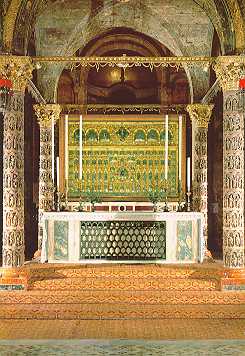
The semi-sacral character of the Doge is central to the enactment of the patriarchino in its developed form; he was not sacred in the sense that the Byzantine Emperor was sacred, but neither was he simply a rather grand version of podesta elected through exclusively civil procedures.(15) The special position of the Doge, analogous in Venetian eyes to that of the Pope in Roman ritual, is often made explicit in the rituals of the patriarchino, most dramatically in ceremonies surrounding the coronation and the burial of the doge himself. On other occasions the priestly nature of the dogeship is made clear through his involvement in liturgical functions; for example, the ceremonies which took place on the four days of the St. Mark's cycle required that the Doge actually participated at Mass in the Basilica by reciting the Ordinary together with four chaplains.(16) It was also on such major feast-days in the Venetian calendar that a strong sense of history and identity was present in parts of the Office. This is particularly true for the service of Second Vespers which became, in effect, a powerful and theatrical evocation of the past glories of the Serenissima. As already noted, this was partly liturgically defined since it was on occasions such as these that the sequences of psalms proscribed by the patriarchino took on a distinctive form (see above, table I). On these more important days in the calendar the cappella marciana, the principal body of musicians attached to the Basilica, was required to be present for this service, and polyphony was performed while the Pala d'oro was open.

High Altar, Ciborium and Pala d'Oro. Venice, St. Mark's Basilica.
This large gold altarpiece, constructed in Constantinople in 976s and much enlarged in the following centuries, occupied a central role in the liturgy. On ferial days and minor feasts it was covered by a second altarpiece, painted by Paolo Veneziano and his sons in 1345. But on major feasts, of which there were some three dozen in the course of the year, Veneziano's altarpiece was removed by an elaborate system of wheels and pulleys to reveal the Pala d'oro to the congregation. When this happened, according to the Ceremoniale of the Basilica 'the singers must sing Vespers in two choirs with psalms set for eight voices.' Encapsulated in this ritual, with its musical embellishments, are many of the essential peculiarities that made the Venetian liturgy, a form that was at once both sacred and civic, so particular to the Republic.(17)